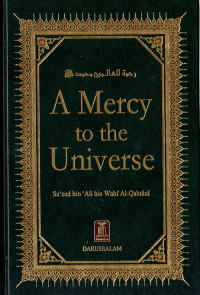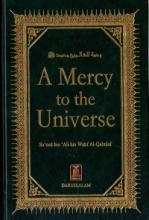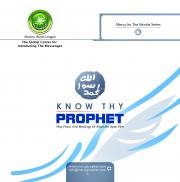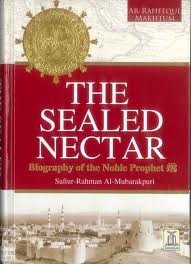The Prophet of Mercy Website
Muslim World League - Global Commission for Introducing the Messenger
By Tanya Cariina Hsu
With His Highness Dr. Nayef bin Fawaaz ibn Sha’alan
The International Program for Introducing the Mercy Prophet; Muslim World League
Excel Hall, London, November 26th, 2006
"They shall have an equal right with our own people to our assistance and good offices …all…domiciled in Yathrib shall form with the Muslims one composite nation; they shall practise their religion as freely as the Muslims; … enjoy the same security … the guilty shall be pursued and punished; the Jews shall join the Muslims in defending Yathrib against all enemies; the interior of Yathrib shall be a sacred place for all who accept this Charter…" [1]
This is part of the official Treaty between the Prophet Muhammad and the tribes living in Medina (then called Yathrib): The Arabs
(Aus, Khazraj), and The Jews (Banu Qainukhah, Banu Quraidah, Banu Natheer).
I mention this contract because so often we hear that the Prophet opposed the Jews. We shall examine this in further detail in a moment.
Why does the West fear Islam? And, by “the West”, I refer to the non-Muslim world, despite millions who are Western via birth and society.
The West has little understanding of Islam, it’s received wisdom generally culled from poor interpretations of the Qu’ran, taken out of context from Muhammad’s Arabia.
Translators often distort modern Arabic writings and speeches with little reference. The dominant Western media with bias, and often ignorance, relies upon political experts speaking of Islam in terms of globalisation and Western democratic values.
Arabic is florid and expressive, whereas English is muted and precise. The language is simply not the same.
The West believes that, in contrast to Jesus, very little is known about Muhammad. In fact, it is precisely the opposite. We know of only 3 years of Jesus’ life. But, we know every element of the Prophet’s life: his childhood, how he slept, how he ate, his bathing habits, and even the details of his marital relations.
Even though many hadith detail his physical description, in Islam no rendering of the Prophet is permitted. In contrast, we do not have a proper image of Jesus. In Africa, he is black; in Europe, he is blue-eyed; in the Orient, his eyes are slanted. Which is it? Jesus was a Jewish Palestinian Arab.
The Reverend Jerry Falwell, one of the most visible Evangelical Christian leaders in the world, called the Prophet “a demon-possessed paedophile.” This stems from the oft-repeated claim that A’isha was betrothed to the Prophet when she was six years old and married at nine. This is not the case: scholars agree that A’isha was thirteen or fourteen at the time the marriage was consummated. This is not unusual even today: teenage mothers in England and America now are provided crèches for their babies in school.
The Reverend Pat Robertson, influential leader of America’s Christian Broadcasting Network television, beaming Evangelism to millions worldwide daily, compares the Qu’ran to Hitler’s “Mein Kampf”.
Robertson wrote that Allah is “under no circumstances…the God of the Bible…Allah was the moon god from Mecca...They are not the same. To translate Allah as God is wrong”. Many in the West thus believe that the God of the Jews, Christians and Muslims is not the same, despite every Muslim on earth knowing that it is.
It is worth pointing out here that, contrary to Christianity or Judaism, Islam does not deny or defame Jesus or any prophet before him - they are all considered prophets of Islam.[2]
The West perceives Islam through its own prism. It views God in man’s image. Therefore, Muslims must worship a god who looks like an old man in the sky with a long white beard. That the angels are bird-winged blonde creatures because this is how they are conditioned. Muslims do not believe this.
The West thinks Islam forbids music, yet Muhammad’s favourite singers are named, and he hushed those who interrupted their song. That Muslim men oppress women, keeping them indoors, or 5 paces behind outside. That he can divorce her by saying “I divorce you”. I live in Saudi Arabia, arguably the most conservative country in the world, and I assure you that Saudi women are tough and would not tolerate such behaviour.
And the ever-recycled “Wahhabi” accusation: there is no such “sect” of Islam, it does not exist, and the Constitution of Saudi Arabia states that the official religion is Islam. Not Sunni Islam. Not Shi’a. Islam, full stop.
It is believed that Muhammad was perpetually marching throughout Arabia in search of battles, spoils, captives and more wives.
Adding all the days of the Prophet’s fighting amounts to no more than one week.
Casualties incurred during all the conflicts in his time amounted to one thousand and eighteen - Muslim, Jew, and pagan combined.
His two biggest battles, the Battle of Badr and the Battle of ‘Uhud, each lasted one day. When the Prophet conquered Mecca, not a drop of blood was shed and all were freed. Muhammad had said, “Abolished are the blood revenges of the days of ignorance.”
Much of the image of violence comes from the aftermath of the Battle of Al-Qandaq, commonly known as the Battle of the Trench. Between four and nine hundred Jews were said to have been killed.
But what really happened?
A riot had broken out near Medina between members of a Jewish tribe and the Muslims, over the desecrated honour of a Muslim woman. It was a matter of time before a major feud would erupt.
It left the Prophet with two choices: either to let the Jewish Bani Qainukah stay and eventually face battle, or banish them. The Prophet ordered them to leave.
Plans were thus made to execute the Prophet and eliminate this growing group of Muslims once and for all.
They first called upon the Prophet’s enemies in Mecca, the Bani Qura’ish, and then to the desert tribe of Ghatafan, to unite. Sending their poets to surrounding tribes, enticing them in to war, they promised the complete support of all the Jewish tribes of Arabia to the pagan Arabs. A ten thousand man army formed.
Now we return to the Treaty I cited in the introduction.
Muhammad’s neighbours, the Jewish tribe of Medina – called the Bani Quraidah - had lived in peace with the Muslims for years. They owned several fortresses a short distance away, and the Prophet relied upon them for safety. They had not only agreed to each other’s individual rights to worship and practise their respective religions but also vowed to protect each other against attack. They had pledged to unite under a single commonwealth, and were legal allies in every sense.[3]
Yet, one of the chiefs planning the attack persuaded them to break this contract, and side with the enemy instead. Having become threatened by the Prophet’s success, they agreed.
The army approached Medina and encamped outside. The Prophet, with 3,000 men, thought it wise to negotiate. This was rejected.
The enemy failed in their attempts to draw the Muslims into the open. The siege lasted twenty days and the tribes had become weary of the protracted campaign. A violent storm approached, uprooted the tents and provisions, and by the morning the enemy fled.
The Muslims had killed four men and lost seven of their own.
Muhammad’s neighbours had violated the Treaty. The Prophet felt betrayed and thus banished the Bani Qouraidah from Medina.
However, victory could not be considered possible as long as they remained in dangerous proximity.
Muhammad’s dominion at the time was one-fiftieth the size of Balmoral Castle in Scotland. There were 5 million people in Arabia. Were punishment not swift word of weakness would spread to other tribes.
They were therefore compelled to surrender.
The Jewish tribe asked for only one condition: that their punishment be left to the judgment of a sympathetic mediator, S’ad ibn Mu’adh of the Aus tribe of Medina. He had been wounded in the attack, and indeed died the next day. Infuriated by their conduct, ibn Mu’adh sentenced the men to death, the women and children spared, according to Jewish law.
The decision was based upon treason not Judaism: being non-Muslim has never been by itself a reason for killing anyone. [4]
However, I would dispute the oft-cited number executed. Nowhere in the Qu’ran is the number written, whereas in other battles and expeditions they are provided. There is a related saying suggesting four hundred were executed; it is not, however, an authenticated hadith, its chain of transmission being vague.
Most often cited is the scholar Ibn Is’haq who’s information came from the descendants of those executed, not the Muslims or Aus and who died 145 years after the event took place. His contemporary, Malik, considered Ibn Is’haq, a liar and impostor for creating “fairy tales”.[5] We often tend to glorify our own sacrificed in battle, exaggerating our gains and losses.
Were the number of deaths actually so high, it would seem to warrant mention in hadith as proof of Muslim strength. It would have been precedent setting. If, in fact, the Prophet were truly against the Jews, the Muslims would have rid all Arabia of them.
The Encyclopaedia Judaica writes that the Golden Age of Jewish culture and jurisprudence was during Muslim rule in Andalusia (Spain). At the same time, Jews were being burnt alive in the Christian world.[6] Despite this, the West uses the “Jewish hatred” template often and erroneously in contemporary references of Islamic intent.
Indeed, given the population at the time of the Bani Quraidah, the number could not have been more than two hundred and fifty executed.[7]
Throughout history, all leaders have killed their enemies in order to survive, to eliminate the adversary. No single society is absent of such.
The kings of England have often been brutal: the Tower of London with its racks, torture chambers and chopping block, is the ultimate testimony to a Bloody England. Europe fiercely fought its neighbours for centuries; 50 million died in its two World Wars.[8]
Up to five million were killed during the Crusades: during the First Crusade, 12,000 Jews were massacred in one of the oldest European settlements. After the Seventh Crusade, 10,000 Jews were killed in Bohemia. In 1499, fifty thousand Muslims in Granada were forced by Cardinal Cisneros to convert to Christianity lest they be killed. The Roman Catholic Inquisition alone killed twelve million. During much of these times, Islam was in its Golden Age of Science, whereas Europe was in the Dark Ages, clothed in sackcloth.
No Muslim nation has ever attacked the West. Could it be, that subsequent Muslim rulers after Muhammad forged their empires in battle for reasons of political and economic gains, fighting as religious men but not necessarily in the name of religion?
How egregious, therefore, was the punishment after Muhammad’s Battle of the Trench? Did it fit the crime?
In the West, punishment of one found guilty of 'collaborating with the enemy’ is severe under the most modern laws. The sentence merely fit the terms of the contract stipulated by the Jews of Medina with the Prophet’s Muslims.
It was the most pivotal moment in Islamic history.
The Prophet made clear that it was prohibited to attack civilians, injure animals, destroy property, pollute the water or even harm a single tree.
In the West, animals were not protected until the Royal Society for the Prevention of Cruelty to Animals was established in 1824; the environment by Greenpeace in 1971, and human rights last, by Human Rights Watch in 1978.
One thousand four hundred years ago, the Prophet established rights for women: inheritance laws, independence, education and voting rights (the biah). Women in England could not vote until 1918, if they were over 30; in America, women were not allowed to vote until 1920; in Switzerland not until 1971. And the notion of the working woman was barely raised in discussion until one hundred and fifty years ago, with considerable opposition.[9]
The Prophet’s first wife was his boss, a wealthy businesswoman 15 years older than he. Multiple wives were common at the time, but he remained married only to her until she died 15 years later. His second wife was 65 when he married her, as was another several years later.
Most of the Prophet’s unions were legal precedents preventing subsequent discrimination. He married a Jew, Christian, older woman, widow, divorcee, virgin, servant and the unprotected.
The West has long interfered in matters of state and culture in the Muslim world, ruling either directly or indirectly. The Muslim world is aware of the imbalance - the indifference to woes dear to Muslims: Palestine, Bosnia, Chechnya, Iraq, Kashmir, and elsewhere.[10]
To the West, the failure of Muslims to keep pace with the West is mainly due to Islam itself. It is accused of being “in the 14th century” (technically it is: it is the Muslim calendar year 1427). That the sooner Muslims adapt to Western ways, the better off they will be.
“The decline of the Muslims was not due to any shortcomings in Islam, but rather their own failure to live up to it”, wrote Austrian author Leopold Weiss.[11]
Islam is seen as a religion based upon “jihad”. The word jihad means “to strive” or “to struggle”. The word for battle is “qittal”. The West tries hard to attribute an incorrect definition.
So why is the Prophet endlessly perceived as a man of violence? We see that in fact he could not have been.
Partly, it is because he symbolises The Man of No Fear. The stereotypical image is of Muhammad on horseback carrying his weapon; it is not an Asian, even though they comprise 80% of Muslims.
The Arab male wears no suit of armour to fight, as do American soldiers in Iraq - protected head to toe. The Arab male wields a sword and rides his horse to battle to face occupying troops - even today in Afghanistan (Afghanis not Arabs, they epitomise such nonetheless).
The Arab humiliates the Western “tough guy” façade and the media image portrayed therein.
The Prophet did not bring Islam with a sword. It was “shwaiya shwaiya maah ibtisaamah” – slowly slowly with a smile.[12]
There is a saying in the West: “Beware the man with nothing to lose”. With nothing to lose in this life, no fear of death in Islam, there is a sense of calm, self-confidence and emotional security in the Muslim.
Modern Western man’s established role of strong protector and provider is disappearing. The Arab Muslim male emasculates him.
The West does not really fear Islam. It is only afraid of the unknown, whether the monster under the bed, or the Arab Muslim. Tomorrow, if aliens landed on earth from outer space, he would suddenly not be as frightening, having been replaced by a new enemy from the unknown.
Samuel Huntington, neoconservative author of “The Clash of Civilisations”, wrote “The West won the world not by the superiority of its ideas or value or religion…but rather by its superiority in applying organised violence…Westerners often forget this fact; non-Westerners never do.”
I prefer to be on the winning side in the end. Thank you.
------------------------------
[1] Syed Ameer bin Ali, “The Spirit of Islam” Cambridge University, 1922
[2] Dr. M.A. Salloomi, “Innocent Victims in the Global War on Terror”, 2006, p. 150; also His Highness Dr. Nayef bin Fawaaz ibn Sha’alan
[3] His Highness Dr. Nayef bin Fawaaz ibn Sha’alan, Paper on the Prophet’s Battles, November 2006
[4] Sheikh Jaafar Idris, Letter to the Pope, International Support of the Final Prophet, September 22nd, 2006
[5] Journal of the Royal Asiatic Society of Great Britain and Ireland, “Did Prophet Muhammad Order 900 Jews Killed?”, 1976, p 100
[6] Encyclopaedia Judaica, (Jerusalem: Keter Publishing), 1971-1972
[7] His Highness Dr. Nayef bin Fawaaz ibn Sha’alan, Paper on the Prophet’s Battles, November 2006
[8] Encyclop?dia Britannica, (Edinburgh: Encyclop?dia Britannica Publishing), 1768
[9] Frances Power Cobbe , "Essays on the Pursuits of Women”, London, 1863.
[10] Dr. M.A. Salloomi, “Innocent Victims in the Global War on Terror”, 2006, p. 150
[11] Leopold Weiss, “The Road to Mecca”, New York, 1954, p.121
[12] Sheikh Aqeel al-Aqeel, Personal Interview, October 2006
Copyright © Tanya Cariina Hsu, November 26th, 2006
No part of this document may be printed or distributed without the author’s express permission.
******






